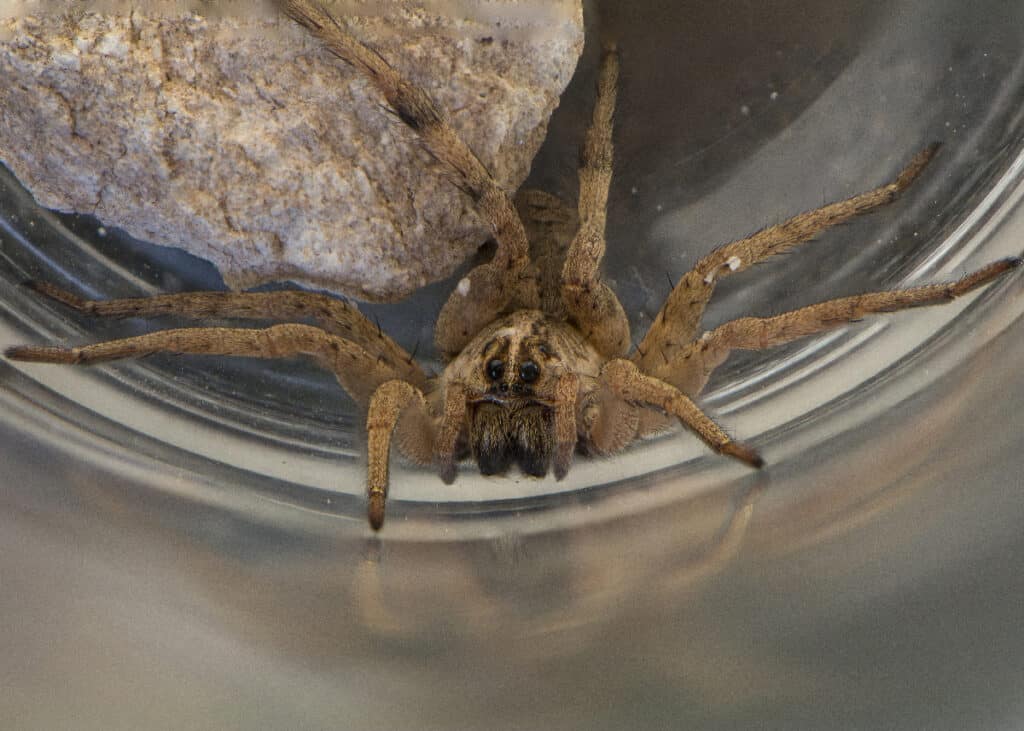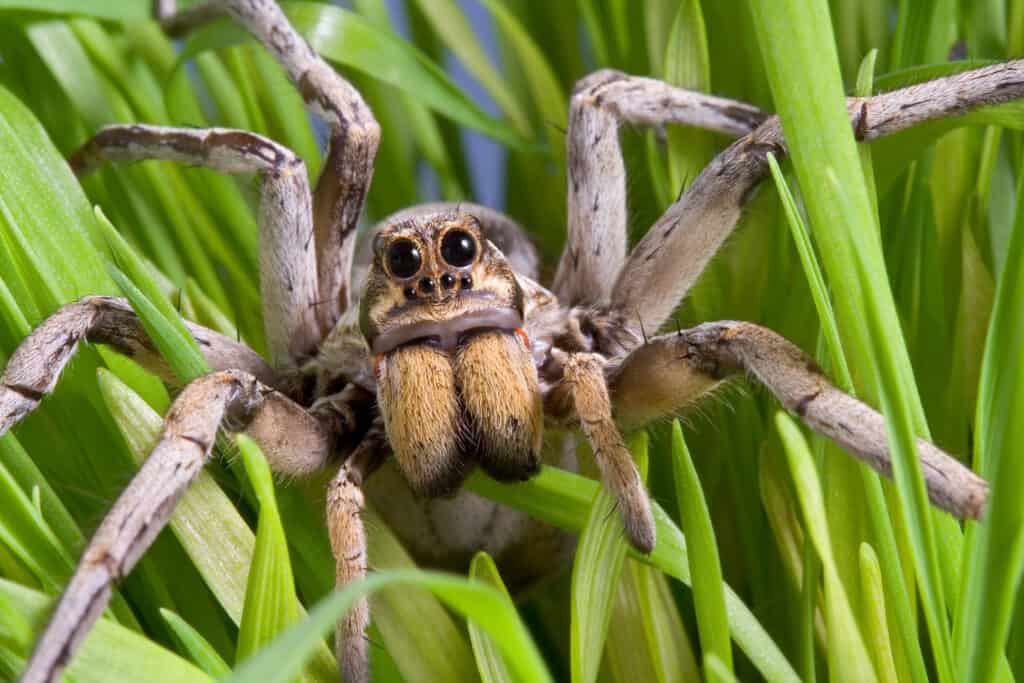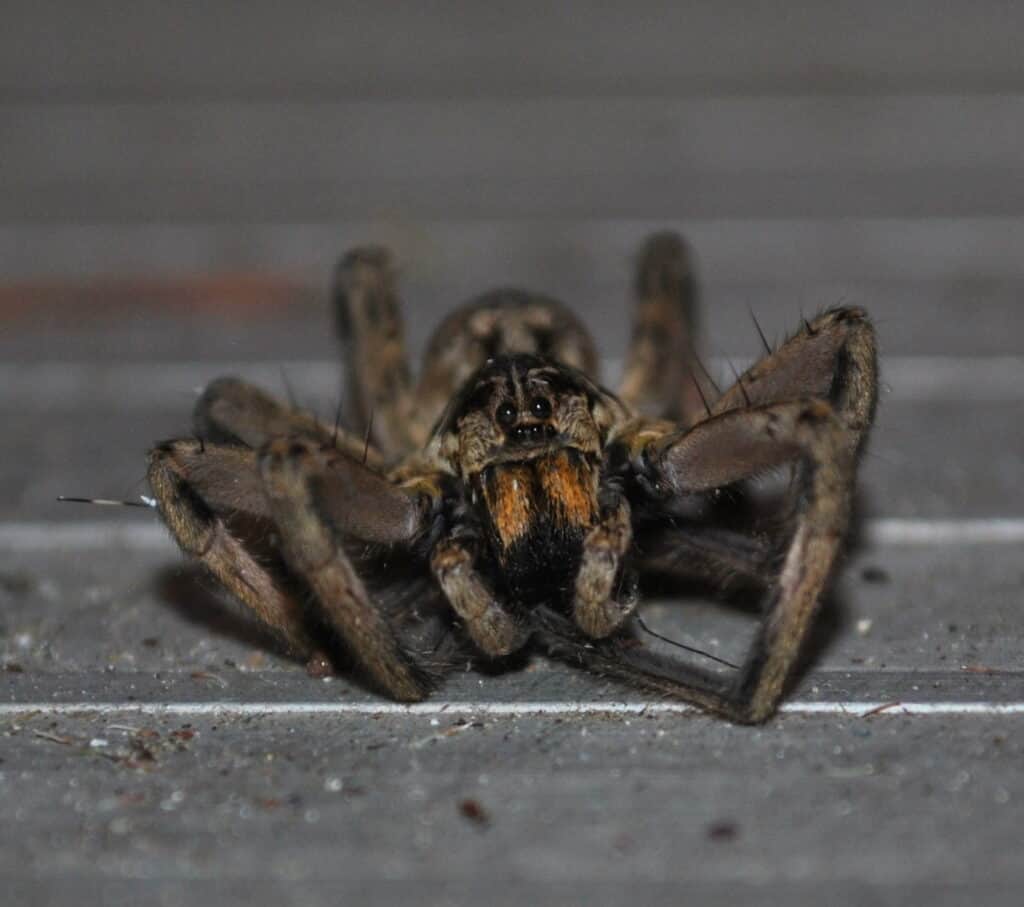Most people feel a little creepy about the subject of spiders. It only gets worse when the spiders in question are big, hairy, and fierce-looking. The wolf spider is an arachnid renowned for its vicious hunting techniques and bulbous eyes. But there’s an upside if you live in Florida: these spiders are great at killing bugs! Read on to find out everything you need to know about wolf spiders in Florida.
What is a Wolf Spider?

Wolf spiders encompass a vast array of spider species within the family
Lycosidae.
©iStock.com/Ledzeppelinriff
Wolf spiders encompass a vast array of spider species within the same family, Lycosidae. Fittingly, this is the Greek word for wolf. Scientists group more than 2,800 species of wolf spiders into 124 genera. More than 30 species of wolf spiders live in Florida. Five of the most common include:
- Santa Rosa wolf spider (Arctosa sanctaerosae)
- Carolina wolf spider (Hogna carolinensis)
- Rabid wolf spider (Rabidosa rabida)
- Field wolf spider (Hogna lenta)
- Beach wolf spider (Arctosa littoralis)
Wolf spiders are so named for a couple of different reasons. The first one has to do with their appearance. Their hairy, often grey bodies appear wolflike to some. As if this isn’t creepy enough, these spiders also resemble wolves in their behavior. Unlike most other spiders, they don’t usually weave webs to trap their prey. Instead, they hunt in a wolfish manner, stalking and then killing their prey with a fatal bite.
How to Identify Florida Wolf Spiders

Florida is home to over 30 species of wolf spiders.
©iStock.com/CathyKeifer
Wolf spiders in Florida vary in appearance according to species. One constant is their prominent, bulging eyes. Spiders in the family Lycosidae have eight eyes: two large main eyes, two smaller ones to either side of the main set, and four small eyes above the mouth. Having so many eyes gives the wolf spider an excellent sense of sight and makes it harder to ambush.
Spiders from this family typically have stout bodies with long legs. Both are hairy. Their mouth appendages are impressively large, packing a powerful bite. They are usually black, brown, or grey in color; tan or light orange markings may occur on the bodies or legs.
How Big Do Florida Wolf Spiders Get?

Florida wolf spiders usually only grow from 0.24 to 1.2 inches long.
©Aaron Carlson / CC BY-SA 2.0, Flickr – License
Despite their fearsome name and reputation, wolf spiders don’t grow as big as some other species. The largest of them has a body length of only 1.2 inches (3 centimeters), though some rare specimens of Carolina wolf spiders have reached 1.5 inches (3.8 centimeters). Carolina wolf spiders are Florida and North America’s largest species of wolf spiders. The most diminutive specimens in the family Lycosidae are as small as 0.24 inches (0.6 centimeters) in length. These measurements do not include leg length.
As with most spiders, wolf spiders are sexually dimorphic. This means there are significant differences between males and females. Females are larger than males, often by a good margin.
Where Are Florida Wolf Spiders Found?
Wolf spiders inhabit almost every part of the state of Florida. They are capable of living either indoors or outdoors. To their horror, homeowners often discover wolf spiders living as pests in the house.
These arachnids prefer dark, enclosed spaces where they can hide, often choosing to inhabit basements or walls. They also like hanging out in gardens, on tall grass, or on the outside walls of houses where insects abound. Species like the Shoreline wolf spider turn up now and then on Florida beaches, hiding under driftwood.
What Do Florida Wolf Spiders Eat?

Wolf spiders mostly eat insects and other spiders.
©Vida Shams/Shutterstock.com
Florida wolf spiders eat a variety of insects and other spiders, taking advantage of Florida’s humid and buggy climate. Once in a while, in addition to their insectivorous diet, they will even eat small reptiles and amphibians like frogs and toads. Their diet includes common insects like ants, beetles, earwigs, roaches, centipedes, and millipedes. Worms and insect eggs also feature prominently. Because their diet includes common household and garden pests, wolf spiders may actually be of benefit to a household.
These arachnids are vicious predators in their own right, running down their prey with uncanny speed and dexterity. Once they catch their victim, they inject venom to liquefy the innards. Then they suck the innards out of the body.
Florida Wolf Spider Predators
Anything with the word “wolf” in its name should be immune to predators, right? Wrong! Wolf spiders may be fearsome to other arachnids and insects, but they themselves are prey for larger creatures. Birds give them the most to worry about. Any large bird of prey poses a problem, though owls have a reputation for hunting spiders. In addition to threats from the sky, wolf spiders may also face attacks from lizards and rodents.
Wolf spiders, in fear for their lives, may choose to detach a leg to escape and survive. Though this limits their mobility in the short term, they can grow the limb back over time. They may also inflict painful bites on the aggressor with their sizeable jaws when attacked.
Are Florida Wolf Spiders Dangerous?

Wolf spiders are not dangerous to humans.
©iStock.com/Henrik_L
Surprisingly, Florida wolf spiders are not dangerous to humans. They are generally unaggressive and elusive, biting only when provoked or cornered. Even when they do bite, their venom isn’t nearly potent enough to kill a human being. At the most, the area around the bite may become mildly red and swollen. As with most spiders in the world, their repulsive appearance inspires more fear than is justified.
Though the sight of a wolf spider may spark feelings of revulsion and fear, experts advise against killing them by crushing them with a shoe or other object. Wolf spiders are the only type of spiders to carry their young on their back; females ferry hundreds of spiderlings around this way. Stepping on a female carrying young might kill her and a few of the spiderlings, but most of them would rapidly disperse. This means potentially hundreds of tiny wolf spiders living and growing in the house. To get rid of a wolf spider you suspect may be carrying young, either invest in a potent bug spray or call an exterminator.
Florida Wolf Spider Lifespan
Most people will be relieved to know that wolf spiders don’t live exceptionally long lives. The majority of species only live 1-2 years, reaching sexual maturity by a few weeks of age. This is essential if they are to have a chance to reproduce.
Though they may appear ferocious and disgusting, wolf spiders in Florida are not a threat to humans. In fact, let them live with you long enough, and you might notice fewer bugs around the house!
The photo featured at the top of this post is © Will E. Davis/Shutterstock.com
Thank you for reading! Have some feedback for us? Contact the AZ Animals editorial team.






